Efforts to halt deforestation falling short

Forest Clearing
What you need to know:
- The study, titled "Off Track And Falling Behind," reveals that the world needed to have restored 5.4 million hectares of deforested land to be on track to eliminate deforestation by 2030.
- Instead, it lost 6.6 million hectares, including 4.2 million hectares of primary tropical forests. The figure is also a four per cent increase of deforestation when compared to 2021.
Last year, despite the commitments made by world leaders to end the loss and degradation of natural forests by 2030 and to restore 350 million hectares of degraded landscapes and forestlands by 2030, the world lost over 6.6 million hectares of trees. This information comes from the Forest Declaration Assessment, which tracks the progress of forest goals.
The study, titled "Off Track And Falling Behind," reveals that the world needed to have restored 5.4 million hectares of deforested land to be on track to eliminate deforestation by 2030. Instead, it lost 6.6 million hectares, including 4.2 million hectares of primary tropical forests. The figure is also a four per cent increase of deforestation when compared to 2021.
“In 2021, the world was also off track on the pathway to 2030 goals; the world needed to make up that lost ground—and more— in 2022. Insufficient progress makes reducing deforestation increasingly difficult in each remaining year leading up to 2030. The next interim target is to reduce global deforestation to 4.8 million hectares (or less) in 2023, meaning the world will need to reduce deforestation by 27.8 per cent from 2022 levels to get on track. This will be a significant challenge,” says the report.
While trees went down, emissions from forests in the same year increased by six per cent compared to 2021. Populations of forest specialist species also declined by 79 per cent owing to habitat loss, habitat degradation, over-exploitation and climate change.
“Degradation was higher than the baseline in tropical and non-tropical regions of Latin America and Africa, while rates decreased in tropical and non-tropical Asia, Europe and North America,” says the report.
“Several regions continue to lose high integrity forests at alarming rates. These include non-tropical and tropical Latin America, non-tropical Africa and boreal and temperate forests in North America and Europe. Comprehensive data on forest degradation, especially in many northern forests, remains insufficient to assess progress and inform needed action adequately,” says the report.
In 2014 and 2021, countries committed to the New York Declaration on Forests and the Glasgow Leaders Declaration of Forest and Land Use, respectively, in which they promised to stop deforestation globally by 2030. However, among the 141 nations that have endorsed the Glasgow commitment to combat deforestation, about 50, including Indonesia and Malaysia, are making significant progress.
A separate global analysis by Forest 500 shows that “201 companies and financial institutions with the most exposure to and influence on tropical deforestation still haven’t set a single policy on deforestation.”
The report adds that most countries still need to prioritise forest goals and only spend 2.2 billion dollars on forest restoration. At the same time, private financial institutions invested 6.1 trillion dollars in companies that use forests or forest lands to produce their products.
Closer home, President William Ruto committed to planting 15 billion trees by 2032, months before he lifted a tree logging ban, a potential reverse in tree restoration gains.
According to Global Forest Watch, Kenya lost 6, 290 hectares of natural forest in 2022, equivalent to 3.29 metric tonnes of carbon dioxide emissions. Besides, “there were 553 deforestation alerts reported in Kenya between October 21, 2023 and October 28, 2023, covering seven hectares.”
It also states that Kenya lost 50,700 hectares of humid primary forest between 2002 and 2022, making up 14 per cent of its total tree cover loss in the same period. It also lost 37,500 hectares of tree cover, equivalent to an 11 per cent decrease since 2000, and 184 metric tonnes of carbon dioxide equivalent emissions.





